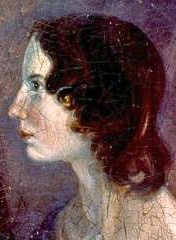Wuthering Heights Contents
Wuthering Heights
Emily Brontë and Wuthering Heights

When Wuthering Heights was first published, it was not well received. The Spectator (in December 1847) complained that ‘the incidents are too coarse and disagreeable to be attractive’ and this was a common complaint, The Athenaeum (December 1847) also calling it a ‘disagreeable story’. Another word used by The Spectator, and by The Examiner (January 1848), was ‘improbable’. In hindsight, we might say that such comments show how untypical the settings and events of Wuthering Heights were, compared to most Victorian novels, meaning that readers were not quite sure how to take the book.
Certainly, in the 150 years that followed, it steadily gained popularity, becoming, for many, a literary treasure.
Today, it still speaks to us, captures us, even moves us.
Emily Brontë
|
Context of Wuthering Heights Wuthering Heights was written in the Victorian Era. The world Emily Bront
ë lived in had a profound effect on her writing and provides a lense through which one can better understand the text. Read more . . . Wuthering Heights was written in the Victorian Era. The world Emily Bront
ë lived in had a profound effect on her writing and provides a lense through which one can better understand the text. Read more . . .
|
Dive in to the Wuthering Heights text guide
Synopsis and commentary - read a chapter by chapter summary and commentary on Wuthering Heights.
Characterisation - find out about the main protagonists in the novel and analyse their characters.
Themes and significant ideas; Imagery, metaphor and symbolism - Research themes, ideas and images that feature in the book.
Wuthering Heights e-book - Read the book and research the text, all for free and online.
How to do well in your Wuthering Heights essayDecide what the key words of the question are, and underline them. Want more essay and exam tips? |
Are you a teacher?Downloadable, free Wuthering Heights teacher materials, ready to be printed and used in class. |
Recently Viewed
Scan and go

Scan on your mobile for direct link.
 Emily Brontë (1818 – 1848) was an English novelist. She had two sisters - Anne and Charlotte, both of whom wrote novels which have since become English literature classics.
Emily Brontë (1818 – 1848) was an English novelist. She had two sisters - Anne and Charlotte, both of whom wrote novels which have since become English literature classics.